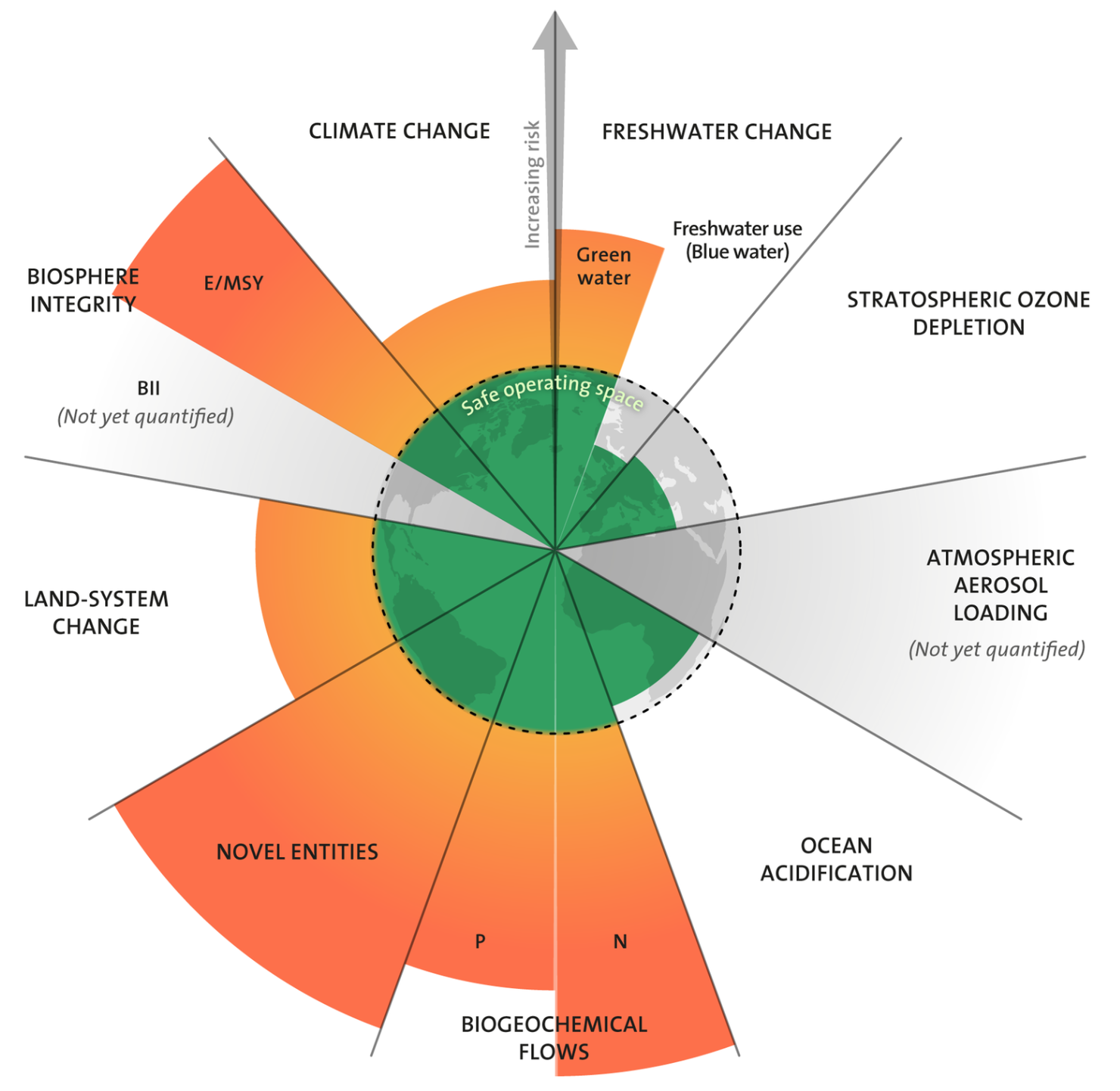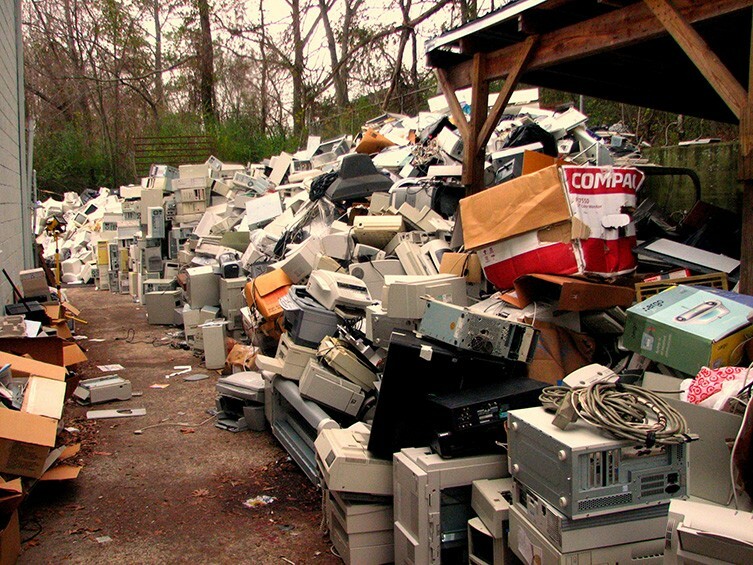Digital Technology and Planetary Boundaries
As our world becomes increasingly interconnected, digital technology has revolutionised the way we live, work, and communicate. However, the rapid growth of technology also poses challenges to the delicate balance of our planet's ecosystems. To ensure a sustainable future, defined as 'meeting the needs of the present without compromising the ability of future generations to meet their own needs', it is crucial that we harness the potential of digital innovation while staying within planetary boundaries. Is it possible to enable digital technology to work harmoniously with the environment and contribute to a sustainable future?
What are Planetary Boundaries?
In 2009, Johan Rockström at the Stockholm Resilience Centre, led a group of scientists to identify nine processes that regulate ecosystems that we depend on for our survival on the planet. Stepping outside of these limits increases the risk of irreversible environmental damage and the ability of current and future generations to continue to live well.
Socio-environmental challenges like climate change are complex and entangled in historical and current economic and geo-political webs. Too complex for any tech solutions to fix. However, with curiosity and continued learning about the systemic consequences of our everyday actions, we can build mindful approaches to our relationship with technology.
Socio-environmental challenges like climate change are complex and entangled in historical and current economic and geo-political webs. Too complex for any tech solutions to fix. However, with curiosity and continued learning about the systemic consequences of our everyday actions, we can build mindful approaches to our relationship with technology.

Azote for Stockholm Resilience Centre, based on analysis in Wang-Erlandsson et al 2022
How digital tech is impacting the planet
The context of digital technology hides many harmful consequences from us, the users and designers.
The processes required to make the digital device we use every day include mining, risky working conditions, toxic impact on health, destruction of land and communities, vast energy demands, heat emissions and e-waste. The extraction of raw materials for electronics is a toxic and harmful process and can involve child labour. The energy consumption used in manufacturing and operation also has significant consequences.
In addition, the production, use and disposal of digital devices is a messy process and lead to environmental and human hazards. E-waste is a huge problem and although recycling may seem like a good solution, many Western countries require costly licensed sites to process the toxic materials found in devices. This is one of many reasons why e-waste is exported to other countries that have fewer labour and safety laws.
The processes required to make the digital device we use every day include mining, risky working conditions, toxic impact on health, destruction of land and communities, vast energy demands, heat emissions and e-waste. The extraction of raw materials for electronics is a toxic and harmful process and can involve child labour. The energy consumption used in manufacturing and operation also has significant consequences.
In addition, the production, use and disposal of digital devices is a messy process and lead to environmental and human hazards. E-waste is a huge problem and although recycling may seem like a good solution, many Western countries require costly licensed sites to process the toxic materials found in devices. This is one of many reasons why e-waste is exported to other countries that have fewer labour and safety laws.
This, some argue, is by design. Producers and manufacturers have few obligations to be transparent about the means with which the software or hardware was created, and what the environmental and social consequences will be to use and dispose of it. This is often described as the 'Make, Take, Dispose' model, as there is little economic incentive to do otherwise. It is still cheaper to buy newly extracted materials than it is to buy recycled and recovered materials from discarded devices. However, this doesn't mean that there are no harmful effects of this way of doing things - it's just not that visible to us as consumers and users.

Piles of mixed electronic waste. Image © Curtis Palmer via Wikimedia Commons.
Ways to address digital sustainability
"Those who have more means to reduce dangerous greenhouse gas emissions also have a greater responsibility to do so." - Johan Rockström, centre researcher
Research into the ways to deal with overstepping planetary boundaries found that the most important areas to address are poverty and inequality. Those countries with access to more resources tend to spend and use more and therefore have a bigger impact on ecosystems as a result. While people and countries with fewer resources tend to have a much smaller material and resource footprint.
So, how can we continue to meet our own needs and comforts, while working towards achieving social and environmental goals?
So, how can we continue to meet our own needs and comforts, while working towards achieving social and environmental goals?
- Repair instead of replace: Buy refurbished devices and switch away from phone contracts that send you a new device every year. Innovation is important, but the environmental toll of the exponential production of new devices is one key reason for climate change. Sell your working but unwanted devices and only recycle them with a dedicated e-waste recycling facility when they can no longer be repaired.
- Emphasise Energy Efficiency: Digital technology relies heavily on energy consumption, and the increasing demand for power poses a threat to the environment. This is due to both the use of energy derived from fossil fuels and although being a preferred option, so does the resource-heavy transition to renewable energy. To mitigate this impact, it is essential to prioritise energy efficiency in digital infrastructure and devices. Tech companies can develop and promote energy-efficient hardware, software, and data centres. Individuals can contribute by using energy-saving settings on their devices, adopting renewable energy sources, and practising responsible power management.
- Foster Circular Economy: The digital industry can significantly contribute to reducing waste and resource depletion by embracing a circular economy approach. Manufacturers can design products with longevity in mind, allowing for repair, upgrade, and recycling. Consumers can support this transition by making informed choices, opting for refurbished or upgradable devices, and properly recycling electronic waste. However, this requires support from governments to enable economic incentives and investment into scaling up circular infrastructure.
- Encourage Sustainable Data Practices: The spread of digital technology has led to an exponential increase in data generation and storage. Cloud providers can prioritise renewable energy sources for their data centres, optimise cooling systems, and implement advanced data management techniques. Users should be mindful of their digital footprint, reducing unnecessary data storage, file sizes and 'digital hoarding', and adopting data privacy practices that minimise energy-intensive data processing. Find inspiration with solar powered websites and the Small File Media Festival.
- Educate and Raise Awareness: To enable digital technology to stay within planetary boundaries, it is essential to educate individuals about the environmental impact of their digital activities. Raising awareness about energy consumption, e-waste, and sustainable digital practices will empower people to make informed choices and take responsible actions. Educational institutions, governments, and organisations can play a significant role in promoting digital literacy with an emphasis on sustainability.
Conclusion
Digital technology has become an integral part of our lives, presenting both challenges and opportunities for sustainability. For a successful switch to keep using digital technology in a sustainable and responsible way, we need to change our digital culture from a compulsive to a more controlled use of digital technologies, built from measuring both the related opportunities and risks.
By prioritising energy efficiency, embracing a circular economy, adopting sustainable data practices, leveraging digital solutions for environmental challenges, and promoting awareness, we can enable digital technology to stay within planetary boundaries. It is through collective efforts that we can harness the potential of technology while safeguarding the delicate balance of our planet for generations to come. Let us embrace a sustainable digital future that fosters harmony between human progress and environmental preservation.
By prioritising energy efficiency, embracing a circular economy, adopting sustainable data practices, leveraging digital solutions for environmental challenges, and promoting awareness, we can enable digital technology to stay within planetary boundaries. It is through collective efforts that we can harness the potential of technology while safeguarding the delicate balance of our planet for generations to come. Let us embrace a sustainable digital future that fosters harmony between human progress and environmental preservation.
Sources:
https://sustainabledevelopment.un.org/content/documents/5987our-common-future.pdf
https://www.stockholmresilience.org/research/planetary-boundaries.html
https://www.stockholmresilience.org/research/research-news/2022-11-10-fair-global-redistribution-of-resources-is-key-for-planetary-stability.html
https://saicmknowledge.org/epi/hazardous-chemicals-electronics
https://www.amnesty.org/en/latest/campaigns/2016/06/drc-cobalt-child-labour/
https://www.thelancet.com/journals/lanplh/article/PIIS2542-5196(21)00263-1/fulltext
https://blog.espares.co.uk/espares/2022/04/better-repair-reuse-appliances-rather-recycle.html
https://www.nhm.ac.uk/discover/what-is-ewaste-and-what-can-we-do-about-it.html
https://solar.lowtechmagazine.com/
https://smallfile.ca/
Written partly with the help of Chat GPT
https://sustainabledevelopment.un.org/content/documents/5987our-common-future.pdf
https://www.stockholmresilience.org/research/planetary-boundaries.html
https://www.stockholmresilience.org/research/research-news/2022-11-10-fair-global-redistribution-of-resources-is-key-for-planetary-stability.html
https://saicmknowledge.org/epi/hazardous-chemicals-electronics
https://www.amnesty.org/en/latest/campaigns/2016/06/drc-cobalt-child-labour/
https://www.thelancet.com/journals/lanplh/article/PIIS2542-5196(21)00263-1/fulltext
https://blog.espares.co.uk/espares/2022/04/better-repair-reuse-appliances-rather-recycle.html
https://www.nhm.ac.uk/discover/what-is-ewaste-and-what-can-we-do-about-it.html
https://solar.lowtechmagazine.com/
https://smallfile.ca/
Written partly with the help of Chat GPT

